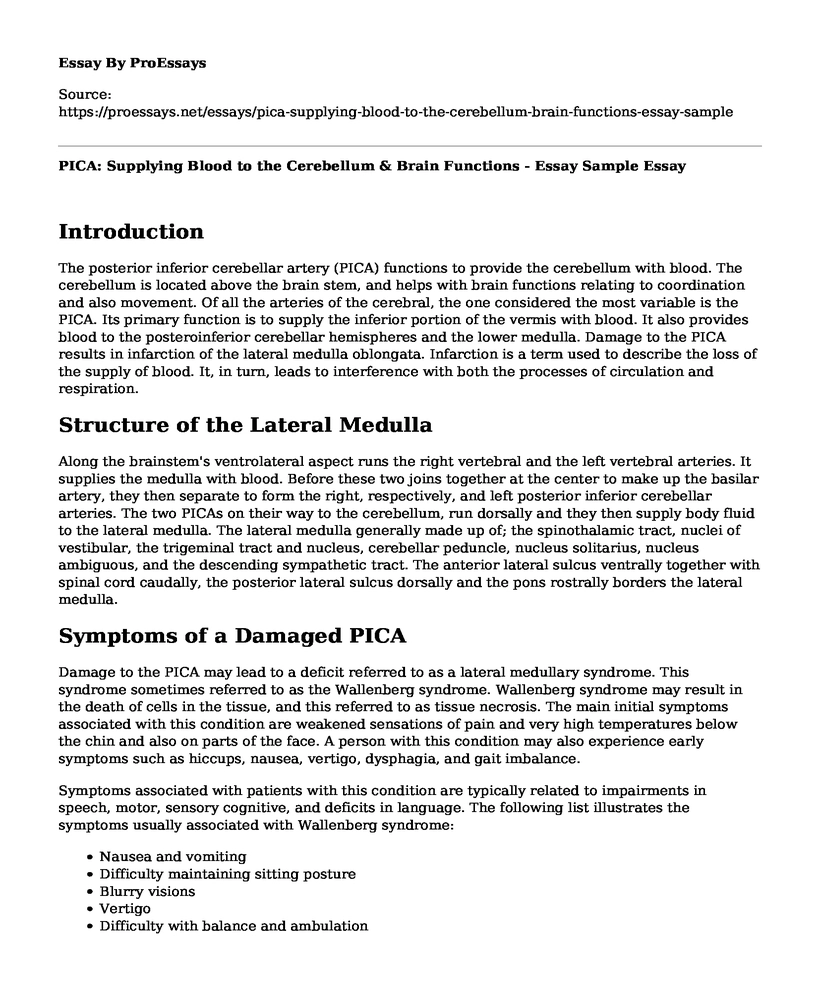Introduction
The posterior inferior cerebellar artery (PICA) functions to provide the cerebellum with blood. The cerebellum is located above the brain stem, and helps with brain functions relating to coordination and also movement. Of all the arteries of the cerebral, the one considered the most variable is the PICA. Its primary function is to supply the inferior portion of the vermis with blood. It also provides blood to the posteroinferior cerebellar hemispheres and the lower medulla. Damage to the PICA results in infarction of the lateral medulla oblongata. Infarction is a term used to describe the loss of the supply of blood. It, in turn, leads to interference with both the processes of circulation and respiration.
Structure of the Lateral Medulla
Along the brainstem's ventrolateral aspect runs the right vertebral and the left vertebral arteries. It supplies the medulla with blood. Before these two joins together at the center to make up the basilar artery, they then separate to form the right, respectively, and left posterior inferior cerebellar arteries. The two PICAs on their way to the cerebellum, run dorsally and they then supply body fluid to the lateral medulla. The lateral medulla generally made up of; the spinothalamic tract, nuclei of vestibular, the trigeminal tract and nucleus, cerebellar peduncle, nucleus solitarius, nucleus ambiguous, and the descending sympathetic tract. The anterior lateral sulcus ventrally together with spinal cord caudally, the posterior lateral sulcus dorsally and the pons rostrally borders the lateral medulla.
Symptoms of a Damaged PICA
Damage to the PICA may lead to a deficit referred to as a lateral medullary syndrome. This syndrome sometimes referred to as the Wallenberg syndrome. Wallenberg syndrome may result in the death of cells in the tissue, and this referred to as tissue necrosis. The main initial symptoms associated with this condition are weakened sensations of pain and very high temperatures below the chin and also on parts of the face. A person with this condition may also experience early symptoms such as hiccups, nausea, vertigo, dysphagia, and gait imbalance.
Symptoms associated with patients with this condition are typically related to impairments in speech, motor, sensory cognitive, and deficits in language. The following list illustrates the symptoms usually associated with Wallenberg syndrome:
- Nausea and vomiting
- Difficulty maintaining sitting posture
- Blurry visions
- Vertigo
- Difficulty with balance and ambulation
- Hiccups
- Horizontal or rotational nystagmus
- Poor gag reflex
- Crossed hemisensory disturbance
- Ataxia, both limb, and gait
- Bradycardia
- Horner's syndrome
- Hoarseness
- Diplopia
- Dysphagia
- Dysphonia
- Contralateral reduction in pain in the trunk and also in temperature sensation
- Ipsilateral reduction in temperature sensation and facial pain
Conclusion
The PICA interruption of the vascular supply may also result in cerebellar dysfunction; this is because the PICA perfuses the cerebellum. Due to the placement of tracts and nuclei and them very compressed in the lateral medulla, Wallenberg syndrome that arises as a result of damage to the posterior inferior cerebellar artery leads to abnormalities in many systems. This condition is most common in middle-aged men who are at the age of around 55.6 years of age. The most significant risk factor associated with the damaged posterior inferior cerebellar artery believed to be extensive artery atherosclerosis, directly linked to the history of smoking, diabetes, and hypertension. Another risk factor is a head injury or mechanical trauma; this is common with young patients. From the symptoms stated, recovery is generally good for patients with cases of unilateral infarct of the lateral medulla and occurs through a mechanism that involves the unaffected side of the medulla.
References
Lee, H. (2008). Sudden deafness related to posterior circulation infarction in the territory of the nonanterior inferior cerebellar artery: frequency, origin, and vascular topographical pattern. European neurology, 59(6), 302-306. ttps://doi.org/10.1159/000121421
Mori, M., Yamahata, H., Yamaguchi, S., Niiro, T., Atsushi, M., Kasuya, J., et al. (2019). Bowhunter's syndrome due to left C7 schwannoma in a patient with bilateral absence of the posterior inferior cerebellar artery. Journal of Orthopaedic Science, 24(5), 939-944. https://doi.org/10.1016/j.jos.2017.04.003
Cite this page
PICA: Supplying Blood to the Cerebellum & Brain Functions - Essay Sample. (2023, Aug 03). Retrieved from https://proessays.net/essays/pica-supplying-blood-to-the-cerebellum-brain-functions-essay-sample
If you are the original author of this essay and no longer wish to have it published on the ProEssays website, please click below to request its removal:
- Effects of Light Intensity and Carbon Dioxide on Photosynthesis
- Research Paper on Animal Breeding
- Plant Viral Infection Essay
- Essay Sample on Genetic Engineering: Eradicating Sickle Cell Disease?
- Paper Example on Identifying Animals With Animal Microchips: A Guide
- Essay Example on Science: Making the World a Better Place
- Report Example on Management of Stormwater







